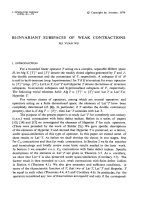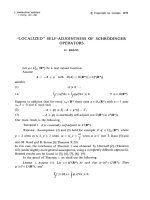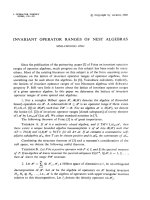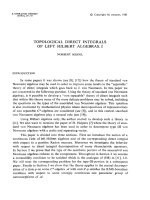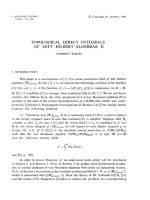Báo cáo toán học: "Semicanonical basis generators of the cluster algebra (1) of type A1" pptx
Bạn đang xem bản rút gọn của tài liệu. Xem và tải ngay bản đầy đủ của tài liệu tại đây (85.67 KB, 5 trang )
Semicanonical basis generators of the cluster algebra
of type A
(1)
1
Andrei Zelevinsky
∗
Department of Mathematics
Northeastern University, Boston, USA
Submitted: Jul 27, 2006; Accepted: Dec 23, 2006; Published: Jan 19, 2007
Mathematics Subject Classification: 16S99
Abstract
We study the cluster variables and “imaginary” elements of the semicanonical
basis for the coefficient-free cluster algebra of affine type A
(1)
1
. A closed formula for
the Laurent expansions of these elements was given by P.Caldero and the author.
As a by-product, there was given a combinatorial interpretation of the Laurent
polynomials in question, equivalent to the one obtained by G.Musiker and J.Propp.
The original argument by P.Caldero and the author used a geometric interpretation
of the Laurent polynomials due to P.Caldero and F.Chapoton. This note provides
a quick, self-contained and completely elementary alternative proof of the same
results.
1 Introduction
The (coefficient-free) cluster algebra A of type A
(1)
1
is a subring of the field Q(x
1
, x
2
)
generated by the elements x
m
for m ∈ Z satisfying the recurrence relations
x
m−1
x
m+1
= x
2
m
+ 1 (m ∈ Z) . (1)
This is the simplest cluster algebra of infinite type; it was studied in detail in [2, 6].
Besides the generators x
m
(called cluster variables), A contains another important family
of elements s
0
, s
1
, . . . defined recursively by
s
0
= 1, s
1
= x
0
x
3
− x
1
x
2
, s
n
= s
1
s
n−1
− s
n−2
(n ≥ 2). (2)
∗
Research supported by NSF (DMS) grant # 0500534 and by a Humboldt Research Award
the electronic journal of combinatorics 14 (2007), #N4 1
As shown in [2, 6], the elements s
1
, s
2
, . . . together with the cluster monomials x
p
m
x
q
m+1
for all m ∈ Z and p, q ≥ 0, form a Z-basis of A referred to as the semicanonical basis.
As a special case of the Laurent phenomenon established in [3], A is contained in
the Laurent polynomial ring Z[x
±1
1
, x
±1
2
]. In particular, all x
m
and s
n
can be expressed
as integer Laurent polynomials in x
1
and x
2
. These Laurent polynomials were explicitly
computed in [2] using their geometric interpretation due to P. Caldero and F. Chapoton
[1]. As a by-product, there was given a combinatorial interpretation of these Laurent
polynomials, which can be easily seen to be equivalent to the one previously obtained by
G. Musiker and J. Propp [5].
The purpose of this note is to give short, self-contained and completely elementary
proofs of the combinatorial interpretation and closed formulas for the Laurent polynomial
expressions of the elements x
m
and s
n
.
2 Results
We start by giving an explicit combinatorial expression for each x
m
and s
n
, in particular
proving that they are Laurent polynomials in x
1
and x
2
with positive integer coefficients.
By an obvious symmetry of relations (1), each element x
m
is obtained from x
3−m
by the
automorphism of the ambient field Q(x
1
, x
2
) interchanging x
1
and x
2
. Thus, we restrict
our attention to the elements x
n+3
for n ≥ 0.
Following [2, Remark 5.7] and [4, Example 2.15], we introduce a family of Fibonacci
polynomials F(w
1
, . . . , w
N
) given by
F (w
1
, . . . , w
N
) =
D
k∈D
w
k
, (3)
where D runs over all totally disconnected subsets of {1, . . . , N}, i.e., those containing no
two consecutive integers. In particular, we have
F (∅) = 1, F (w
1
) = w
1
+ 1, F (w
1
, w
2
) = w
1
+ w
2
+ 1.
We also set
f
N
= x
−
N +1
2
1
x
−
N
2
2
F (w
1
, . . . , w
N
)|
w
k
=x
2
k+1
, (4)
where k stands for the element of {1, 2} congruent to k modulo 2. In view of (3), each
f
N
is a Laurent polynomial in x
1
and x
2
with positive integer coefficients. In particular,
an easy check shows that
f
0
= 1, f
1
=
x
2
2
+ 1
x
1
= x
3
, f
2
=
x
2
1
+ x
2
2
+ 1
x
1
x
2
= s
1
. (5)
Theorem 2.1 [2, Formula (5.16)] For every n ≥ 0, we have
s
n
= f
2n
, x
n+3
= f
2n+1
. (6)
In particular, all x
m
and s
n
are Laurent polynomials in x
1
and x
2
with positive integer
coefficients.
the electronic journal of combinatorics 14 (2007), #N4 2
Using the proof of Theorem 2.1, we derive the explicit formulas for the elements x
m
and s
n
.
Theorem 2.2 [2, Theorems 4.1, 5.2] For every n ≥ 0, we have
x
n+3
= x
−n−1
1
x
−n
2
(x
2(n+1)
2
+
q+r≤n
n − r
q
n + 1 − q
r
x
2q
1
x
2r
2
); (7)
s
n
= x
−n
1
x
−n
2
q+r≤n
n − r
q
n − q
r
x
2q
1
x
2r
2
. (8)
3 Proof of Theorem 2.1
In view of (3), the Fibonacci polynomials satisfy the recursion
F (w
1
, . . . , w
N
) = F (w
1
, . . . , w
N−1
) + w
N
F (w
1
, . . . , w
N−2
) (N ≥ 2). (9)
Substituting this into (4) and clearing the denominators, we obtain
x
N
f
N
= f
N−1
+ x
N −1
f
N−2
(N ≥ 2). (10)
Thus, to prove (6) by induction on n, it suffices to prove the following identities for all
n ≥ 0 (with the convention s
−1
= 0):
x
1
x
n+3
= s
n
+ x
2
x
n+2
; (11)
x
2
s
n
= x
n+2
+ x
1
s
n−1
. (12)
We deduce (11) and (12) from (2) and its analogue established in [6, formula (5.13)]:
x
m+1
= s
1
x
m
− x
m−1
(m ∈ Z). (13)
(For the convenience of the reader, here is the proof of (13). By (1), we have
x
m−2
+ x
m
x
m−1
=
x
2
m−1
+ x
2
m
+ 1
x
m
x
m−1
=
x
m−1
+ x
m+1
x
m
.
So (x
m−1
+ x
m+1
)/x
m
is a constant independent of m; setting m = 2 and using (2), we
see that this constant is s
1
.)
We prove (11) and (12) by induction on n. Since both equalities hold for n = 0 and
n = 1, we can assume that they hold for all n < p for some p ≥ 2, and it suffices to prove
them for n = p. Combining the inductive assumption with (2) and (13), we obtain
x
1
x
p+3
= x
1
(s
1
x
p+2
− x
p+1
)
= s
1
(s
p−1
+ x
2
x
p+1
) − (s
p−2
+ x
2
x
p
)
= (s
1
s
p−1
− s
p−2
) + x
2
(s
1
x
p+1
− x
p
)
= s
p
+ x
2
x
p+2
,
the electronic journal of combinatorics 14 (2007), #N4 3
and
x
2
s
p
= x
2
(s
1
s
p−1
− s
p−2
)
= s
1
(x
p+1
+ x
1
s
p−2
) − (x
p
+ x
1
s
p−3
)
= (s
1
x
p+1
− x
p
) + x
1
(s
1
s
p−2
− s
p−3
)
= x
p+2
+ x
1
s
p−1
,
finishing the proof of Theorem 2.1.
4 Proof of Theorem 2.2
Formulas (7) and (8) follow from (11) and (12) by induction on n. Indeed, assuming that,
for some n ≥ 1, formulas (7) and (8) hold for all the terms on the right hand side of (11)
and (12), we obtain
x
n+3
= x
−1
1
(s
n
+ x
2
x
n+2
)
= x
−n−1
1
x
−n
2
(
q+r≤n
n − r
q
n − q
r
x
2q
1
x
2r
2
+(x
2(n+1)
2
+
q+r≤n−1
n − 1 − r
q
n − q
r
x
2q
1
x
2(r+1)
2
))
= x
−n−1
1
x
−n
2
(x
2(n+1)
2
+
q+r≤n
n − r
q
(
n − q
r
+
n − q
r − 1
)x
2q
1
x
2r
2
)
= x
−n−1
1
x
−n
2
(x
2(n+1)
2
+
q+r≤n
n − r
q
n + 1 − q
r
x
2q
1
x
2r
2
),
and
s
n
= x
−1
2
(x
n+2
+ x
1
s
n−1
)
= x
−n
1
x
−n
2
(x
2n
2
+
q+r≤n−1
n − 1 − r
q
n − q
r
x
2q
1
x
2r
2
+
q+r≤n−1
n − 1 − r
q
n − 1 − q
r
x
2(q+1)
1
x
2r
2
)
= x
−n
1
x
−n
2
q+r≤n
(
n − 1 − r
q
+
n − 1 − r
q − 1
)
n − q
r
x
2q
1
x
2r
2
= x
−n
1
x
−n
2
q+r≤n
n − r
q
n − q
r
x
2q
1
x
2r
2
,
as desired.
the electronic journal of combinatorics 14 (2007), #N4 4
References
[1] P. Caldero, F. Chapoton, Cluster algebras as Hall algebras of quiver representations,
Comment. Math. Helv. 81 (2006), 595-616.
[2] P. Caldero, A. Zelevinsky, Laurent expansions in cluster algebras via quiver repre-
sentations, Moscow Math. J. 6 (2006), 411-429.
[3] S. Fomin and A. Zelevinsky, Cluster algebras I: Foundations, J. Amer. Math. Soc.
15 (2002), 497–529.
[4] S. Fomin, A. Zelevinsky, Y -systems and generalized associahedra, Ann. in Math. 158
(2003), 977–1018.
[5] G. Musiker, J. Propp, Combinatorial interpretations for rank-two cluster algebras of
affine type, Electron. J. Combin. 14 (2007), R15.
[6] P. Sherman, A. Zelevinsky, Positivity and canonical bases in rank 2 cluster algebras
of finite and affine types, Moscow Math. J. 4 (2004), 947–974.
the electronic journal of combinatorics 14 (2007), #N4 5

